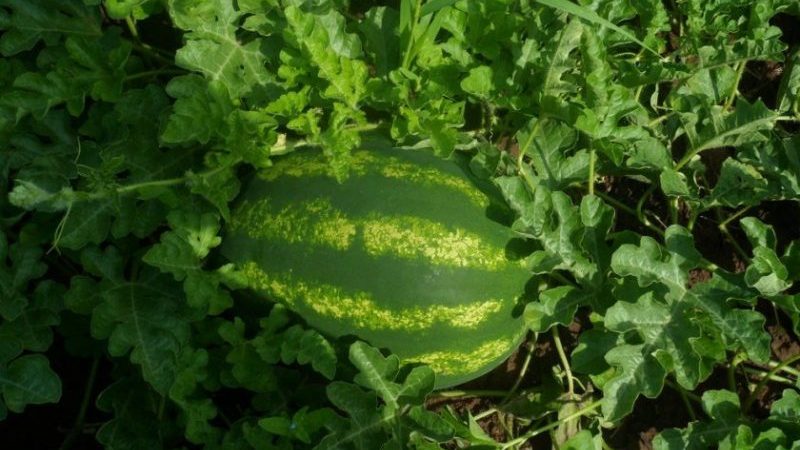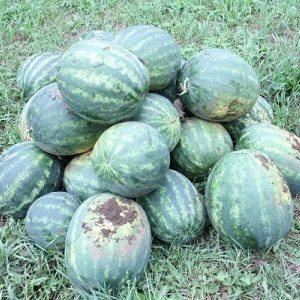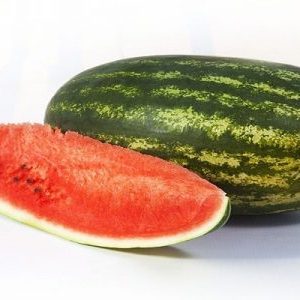Early ripe hybrid watermelon "Ataman" with giant fruits and unique taste
Early ripe watermelon Ataman is grown in the middle lane and in the south of our country. The hybrid is resistant to diseases, shows a stable yield every year. It is planted in open ground, pre-preparing the seedlings.
In the article, we will consider in detail what the Ataman watermelon is and how to get a rich and tasty harvest on your site.
The content of the article
Description of watermelon
Ataman ripens in 45–55 days from the moment the first shoots appear. The bush is powerful, the leaves are large. On one plant, from four to six ovaries are formed simultaneously.
Distinctive features
Hybrid care does not require special knowledge and skills, it is immune to weeds and insect pests. The ataman forms fruits in concert, his fruiting period is extended.

Composition, properties, benefits, calories
The pulp contains vitamins A, E, C and trace elements... Watermelon is famous for its diuretic effect, removes toxins and toxins from the body. 100 g of watermelon contains 25 kcal, 90% of it consists of water.
The berry has a beneficial effect on metabolic processes, improves digestion, relieves bloating and inflammation of the intestines. Watermelon is rich in ascorbic acid and niacin, which strengthen the immune system and protect the human body from premature aging.
Fruit characteristics and yield
The fruits are oval-round, dark green in color with light stripes. The peel is firm and firm, glossy. Fruit weight - 4-14 kg. The pulp is rich in fiber, bright red, juicy and sweet. Productivity - about 5 kg per 1 sq. m.
Seeds of watermelon
Seeds are small, brown color. The surface is smooth, with small spots. Seeds are not eaten.
How to grow yourself
The Ataman hybrid is grown in seedlings. This will help protect the crop from pests and diseases, and increase yields.
Planting and growing seedlings
The seeds of the Ataman hybrid are purchased from trusted manufacturers. When buying, pay attention to the shelf life and integrity of the package... The seeds are checked for germination - they are placed in a saline solution for 15 minutes and stirred clockwise. The seeds that sink to the bottom are used for planting.
After that, the material is disinfected with Bordeaux liquid or Fitosporin-M. The procedure improves seed germination and increases yields.
A convenient container is prepared for growing seedlings. Use flower pots, plastic cups, tray cassettes. The container is washed with a soda solution and wiped dry with a clean towel. For a watermelon, light nutritious soil from the garden or ready-made soil from a store is suitable. It is recommended to disinfect the ground with a weak solution of potassium permanganate before planting.
Soil is poured into the container and grooves are made at a distance of 7-10 cm from each other. Warm water is poured into each and two seeds are placed. Sprinkle with earth on top and slap. The hybrid is watered every 5 days, two weeks after planting, liquid organic fertilizers are applied - manure, chicken droppings, humus.
The containers are stored on a sunny windowsill - a watermelon needs a lot of light and heat for healthy development.
Planting in the garden and care
Before planting, prepare the beds. The melon crop loves a mixture of sandy loam and loamy soils with neutral acidity... It is recommended to dig up the soil at the end of October, before the first snow. Manure is applied to fertilize it - during the winter it will saturate the earth with nutrients.
The soil is re-dug up in March, removing weeds and debris. If the soil is acidic, then liming is carried out before planting - sprinkle with a mixture of dry lime and wood ash.
Important! In the beds, holes are prepared, the depth of each is about 8 cm. A cloudy, windless morning is chosen for disembarkation. A seedling is placed in each hole, the base of the stem is sprinkled with earth. It is recommended to use mulch - a mixture of sawdust, leaves and grass. It nourishes the roots and retains moisture in the ground.
Care includes regular watering and feeding. Water the plant every 3-4 days, spend about 2 liters per bush. In addition to moisturizing the roots, spraying from a spray bottle is required - they accelerate the development of fruits. Use clean water at room temperature - cold water can provoke the appearance of fungi and viruses.
Watermelon is fed with organic and mineral fertilizers - manure, ash, yeast, grass infusion, potassium salt, ammonium nitrate, superphosphate. During the growing period, fertilizers are applied 3-4 times with an interval of 10 days. Top dressing strengthens roots and stems, protects against insect pests, improves the marketability and taste of fruits.
Features of cultivation and possible difficulties
When growing a watermelon in a greenhouse, a number of rules are followed. High humidity is characteristic of closed grounds, so the plant is watered twice a week. If the summer is rainy and hot, then once. Every day, the greenhouse is ventilated with vents, doors and windows are opened.
When the ovaries form fruit, the plant is tied to a support so that the stem does not break. In a greenhouse, the hybrid is grown in one stem, pinch the top and remove the side shoots.
In the open field, after planting seedlings, the plant is covered with thin glass or polyethylene. This protects young bushes from possible frost, winds and rain. Remove protection after a week.
To increase yields, monitor the amount of dressings applied. If the leaves become thin, this is a sign of an excess of nitrogen. The appearance of ulcers signals an excess of phosphorus. To solve the problem, the beds are abundantly watered and sprinkled with dry wood ash.
Diseases and pests
Diseases and pests appear due to improper care, heat or humidity, thickened planting. On watermelon beds there are:
- Olive spot. Occurs from weeds and plant debris, contaminated soil. The fungus can grow in open ground and in greenhouse conditions. Brown spots appear on the leaves and fruits, within 8-12 days the disease covers the entire plant. For the prevention and treatment of olive spot, the drug "Quadris" is used.
- Bacteriosis (angular spotting) develops due to insects that carry dangerous germs throughout the garden. Infected plants have light spots on the leaves, then they become full of holes and soon the bushes die. For prophylaxis, spraying with milk serum and iodine is used, for treatment - a solution of copper sulfate or Bordeaux liquid.
- Melon aphid - a small insect that settles on the inside of the leaf. It feeds on plant sap, over time a dark bloom forms on the bushes. For prevention, it is recommended to plant garlic, onions, and herbs next to the watermelon. For treatment, drugs "Commander" or "Karate" are used.
- Sprout fly dangerous in that its larvae hide inside the stem and destroy it. To prevent its appearance, loosening and weeding of beds, disinfection of seeds are used. For treatment, use means "Iskra" or "Karbofos".
Harvesting and application of the crop

Harvested in August, when the fruits become glossy and firm. The berries are removed along with the stalk, wiped with a dry napkin and laid out on the beds for several hours.Thanks to their dense skin, watermelons can be stored for up to a month without losing their taste and health benefits.
Due to their low calorie content and vitamin composition, they are used for preparing dietary meals - fruit salads, cocktails, juices.
Interesting... Hybrid Ataman is great for winter preparations... Sweet watermelon peels and lemon are made jam, prepared from the pulp compote... Watermelon is also found in recipes for making nutritious snacks. Its sweet taste is paired with cheese, ham, olives and shrimp.
Advantages and disadvantages
The Ataman hybrid has no significant drawbacks. However, watermelon is only suitable for growing in warm, temperate regions. However, he has a number of advantages:
- sweet sugary pulp;
- resistance to diseases and pests;
- unpretentious care;
- universality of application;
- stable yield;
- good keeping quality.
Conclusion
Early ripe watermelon Ataman is suitable for cultivation in the middle lane and in the south of the country. To grow the Ataman f1 hybrid, seedlings are prepared, having previously disinfected the seeds. Seedlings are regularly watered with warm water and fertilized with liquid organic matter. They are planted on sunny and light lands, cleared of debris.
Watermelon ripens in 50 days, it has large fruits and tasty pulp. The ripeness of the crop is determined by the glossy rind and sweet aroma. Fresh Atamana is used for making sweet desserts and healthy dietary meals.